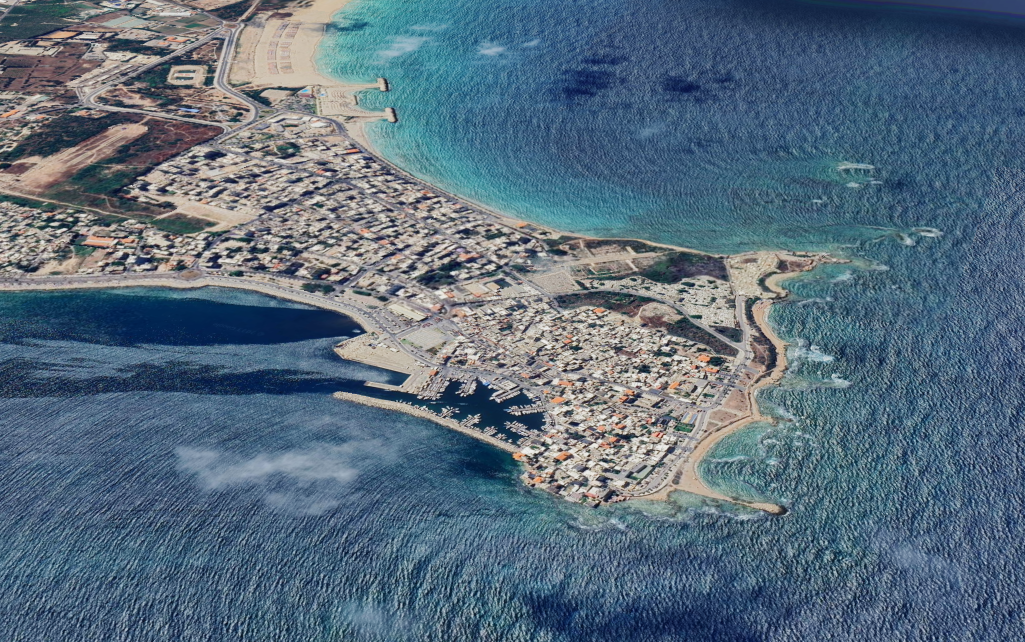Tyre
| Transliterated Name | Source | Name |
|---|---|---|
| Tyre | Arabic | صور |
| Tyrus | Latin | |
| Tyros | Greek | Τύρος |
| Sur | Phoenician | |
| Ṣurru | Akkadian | |
| Tzór | Hebrew | צוֹר |
Tyre started out as an island known as Sur which was eventually joined to the mainland. It has been occupied since the Bronze Age ( Marriner et al, 2005). Marriner et al (2005) provides the following background
Mother of Carthage and one of the greatest Phoenician city-states, Tyre’s golden age spanned between the 9th to 6th centuries BC, during which period it enjoyed an extensive zone of influence incorporating large areas of the Mediterranean basin. Although Tyre lost its hegemony after 572/3 BC, when it fell under Persian influence, the city continued to prosper through the Hellenistic, Roman and Byzantine periods as attest the many impressive archaeological remains today visible in the city.William A. Ward in Meyers et al (1997) relates the following
Classical tradition states that King Hiram (969-936 BCE) joined the two reefs with landfill, enlarging the city to about 40 acres. In succeeding reigns, further enlargement allowed the creation of ports on the northern and southern sides of tire island. This island stronghold was joined to the mainland by Alexander the Great in 332 BCE, who constructed a causeway from the mainland in order to subjugate the city. By Roman times sand from sea currents quickly built up against this causeway, forming the present isthmus. Tyre was essentially an administrative and religious center dependent on food and water supplies from its "sister town," Ushu, on the coast, which stood amid rich and well-watered agricultural land. Ushu is known only from literary references as it lies beneath the modern city.
- Fig. 2 Location of cores and
coastal bathymetry from Marriner et al (2005)

 Fig. 2
Fig. 2
Tyre, location of cores and coastal bathymetry. The strongest winds and swell derive from the south-west. Core sites are marked by a black dot.
Marriner et al (2005) - Fig. 14 Reconstructed palaeobathymetry
of Tyre around 6000 years BP from Marriner et al (2005)
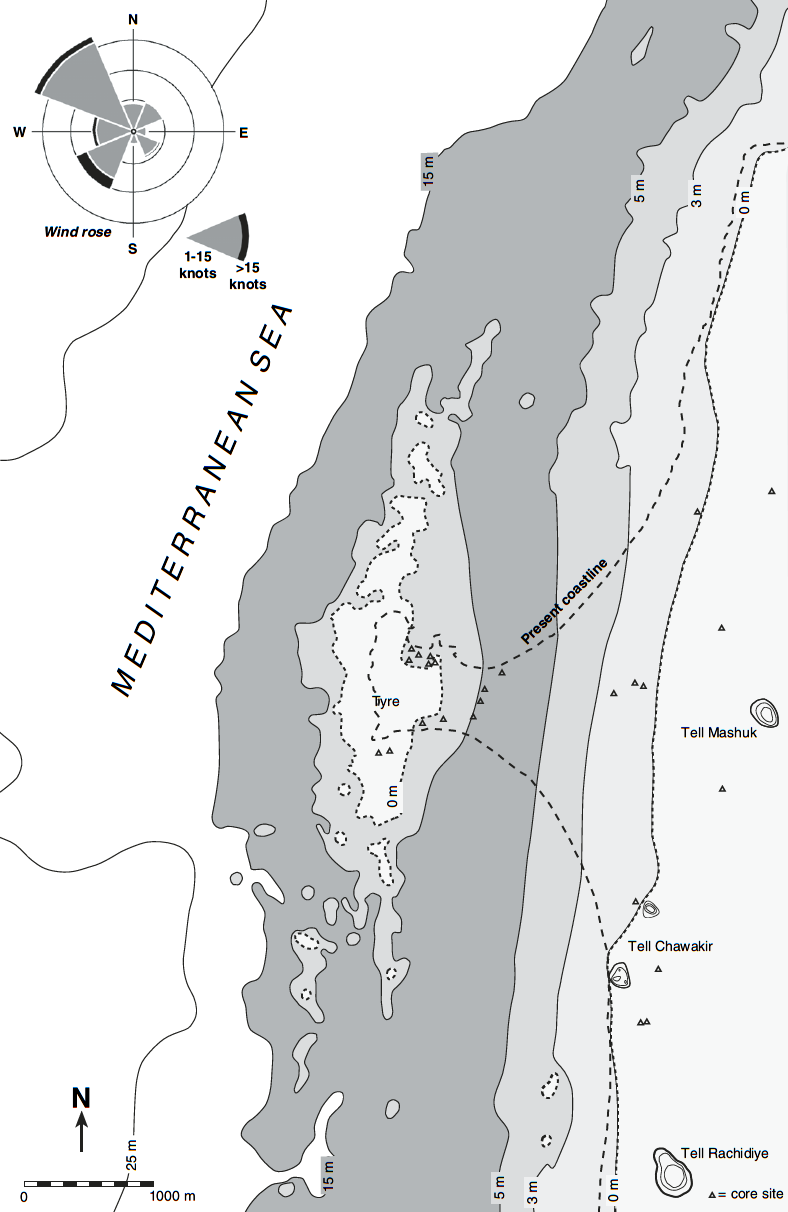
 Fig. 14
Fig. 14
Reconstructed palaeobathymetry of Tyre around 6000 years BP. Coastline reconstructed using stratigraphy, present bathymetry and geochronology.
Marriner et al (2005) - Fig. 17 Aerial photograph with
core locations from Marriner et al (2005)

 Fig. 17
Fig. 17
Maximum extension of Tyre’s MBA northern harbour (1950s aerial photograph). Our work reveals the ancient harbour was ca. 40% larger than present, the extra surface area lying beneath the Medieval and Modern city centres
Marriner et al (2005) - Tyre in Google Earth
- Fig. 2 Location of cores and
coastal bathymetry from Marriner et al (2005)

 Fig. 2
Fig. 2
Tyre, location of cores and coastal bathymetry. The strongest winds and swell derive from the south-west. Core sites are marked by a black dot.
Marriner et al (2005) - Fig. 14 Reconstructed palaeobathymetry
of Tyre around 6000 years BP from Marriner et al (2005)

 Fig. 14
Fig. 14
Reconstructed palaeobathymetry of Tyre around 6000 years BP. Coastline reconstructed using stratigraphy, present bathymetry and geochronology.
Marriner et al (2005)
- Fig. 1 Site plan from
Gatier et al (2011)

 Fig. 1
Fig. 1
General plan of the site
Inventory 2009 (G. Ch., C. D., Cl. P., X. H., Mission de Tyr)
Gatier et al (2011) - Fig. 6 Plan of the thermal
complex and residential area Gatier et al (2011)

 Fig. 6
Fig. 6
(G. Ch., C. D., X. H., Mission de Tyr)
Gatier et al (2011)
- Fig. 1 Site plan from
Gatier et al (2011)

 Fig. 1
Fig. 1
General plan of the site
Inventory 2009 (G. Ch., C. D., Cl. P., X. H., Mission de Tyr)
Gatier et al (2011) - Fig. 6 Plan of the thermal
complex and residential area Gatier et al (2011)

 Fig. 6
Fig. 6
(G. Ch., C. D., X. H., Mission de Tyr)
Gatier et al (2011)
-
Fig. 3 Macrofauna core TV
from Marriner et al (2005)
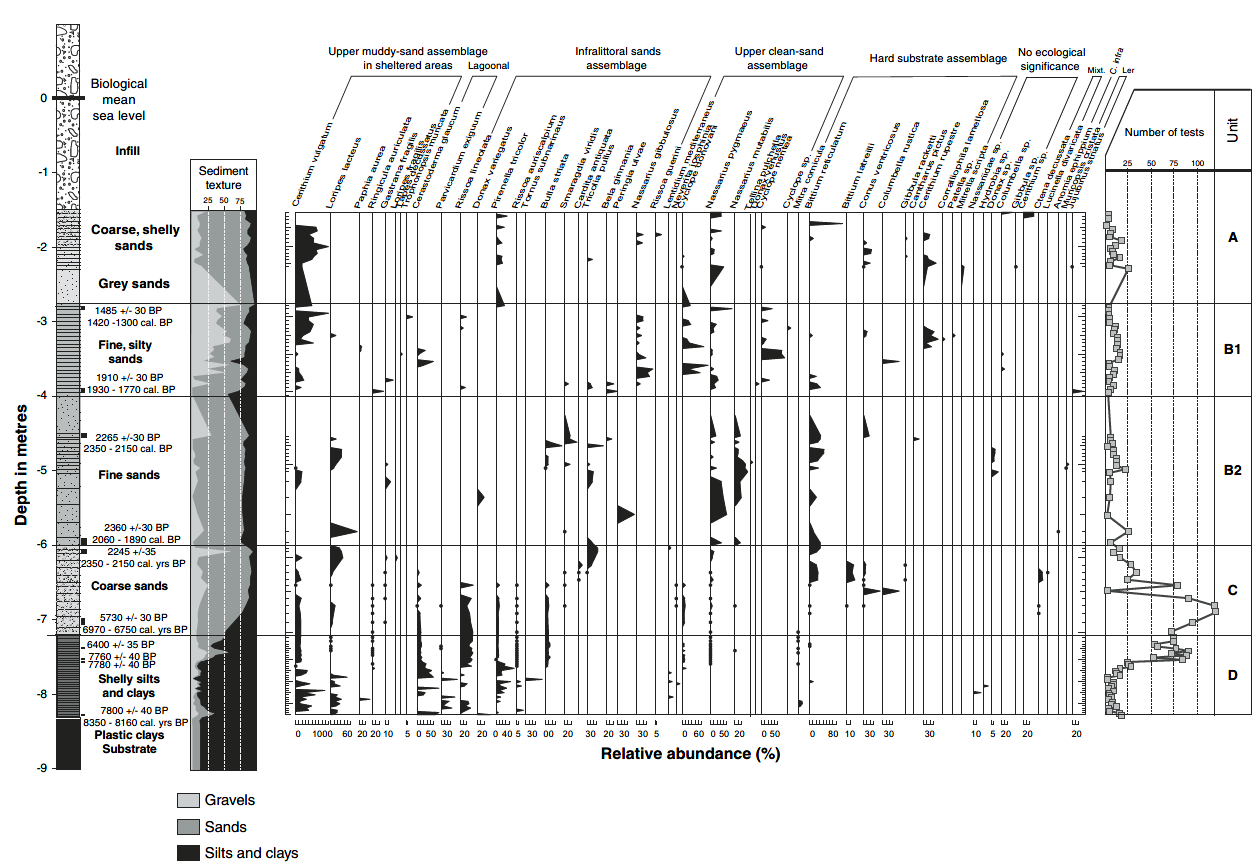
 Fig. 3
Fig. 3
Macrofauna core TV.
Marriner et al (2005) -
Fig. 4 Ostracoda core TV
from Marriner et al (2005)

 Fig. 4
Fig. 4
Ostracoda core TV.
Marriner et al (2005) -
Fig. 8 Grain size analyses
core TIX from Marriner et al (2005)

 Fig. 8
Fig. 8
Grain size analyses core TIX.
Marriner et al (2005) -
Fig. 9 Grain size analyses
core TI from Marriner et al (2005)

 Fig. 9
Fig. 9
Grain size analyses core TI.
Marriner et al (2005) -
Fig. 10 Macrofauna core
TIX from Marriner et al (2005)
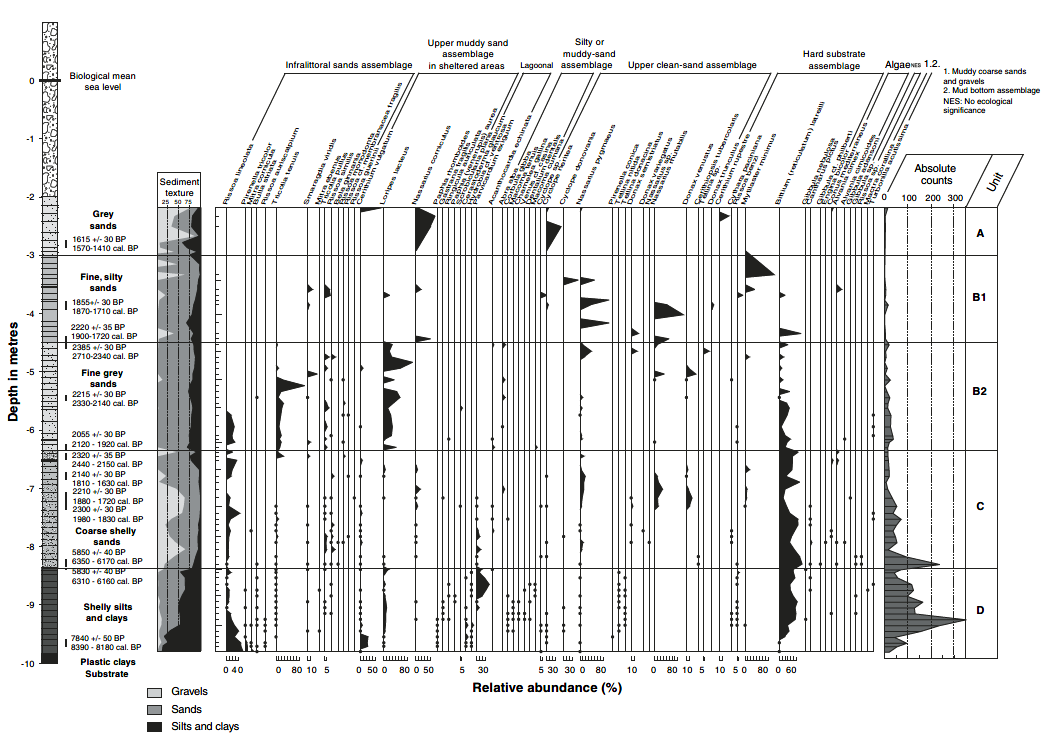
 Fig. 10
Fig. 10
Macrofauna core TIX.
Marriner et al (2005) -
Fig. 11 Macrofauna core
TI from Marriner et al (2005)
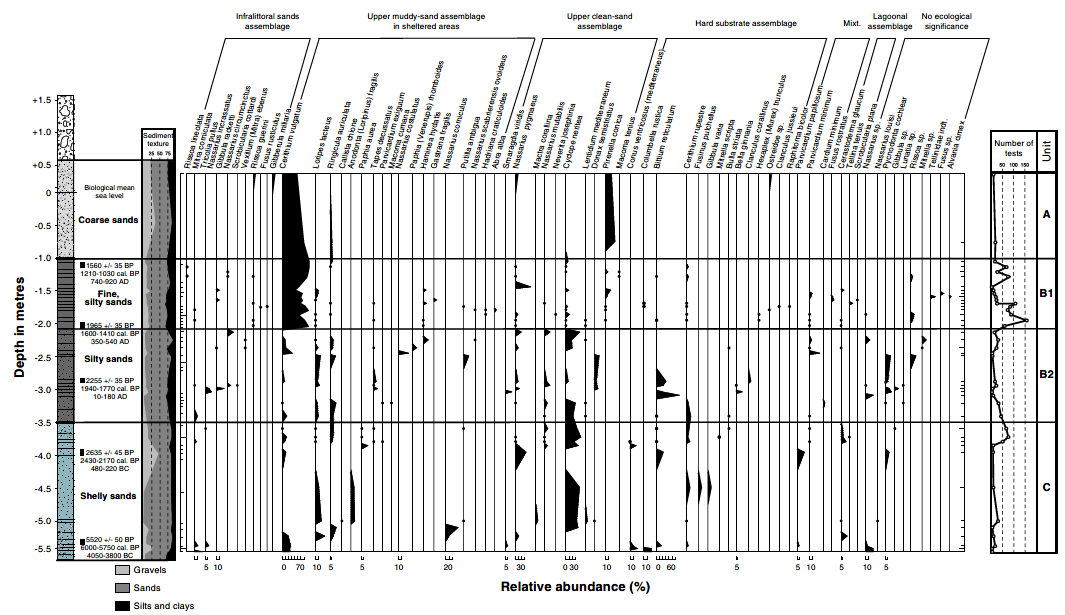
 Fig. 11
Fig. 11
Macrofauna core TI.
Marriner et al (2005) -
Fig. 12 Ostracoda core TI
from Marriner et al (2005)

 Fig. 12
Fig. 12
Ostracoda core TI.
Marriner et al (2005) -
Fig. 13 Foraminifera core
TI from Marriner et al (2005)
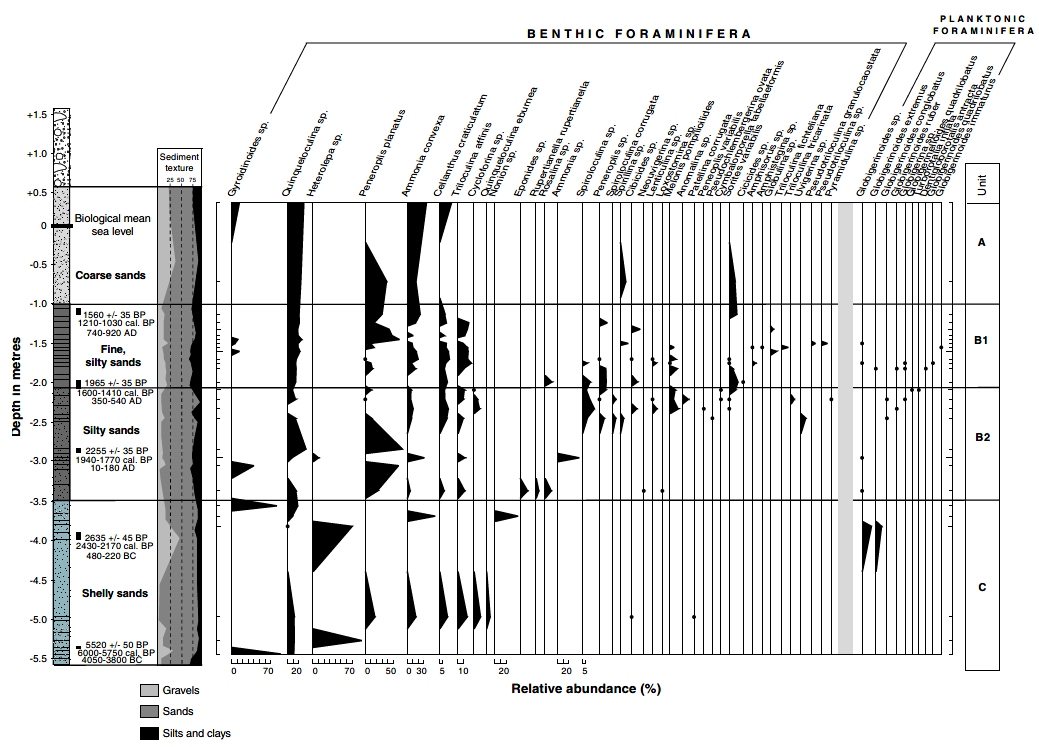
 Fig. 13
Fig. 13
Foraminifera core TI.
Marriner et al (2005) -
Cross-correlation of stratigraphic
units from cores in the northern harbour from Marriner et al (2005)

 Fig. 16
Fig. 16
Cross-correlation of stratigraphic units from cores in the northern harbour.
Marriner et al (2005)
Marriner et al (2005) undertook a litho and biostratigraphical study of four core sequences from the landward edge of the current harbor. AMS radiocarbon dating was performed on dateable material found in the cores. They attributed missing 1st millennium BCE strata to dredging activity undertaken in the Roman and Byzantine periods.
Marriner et al (2005) undertook a litho and biostratigraphical study of four core sequences from the landward edge of the current harbor. AMS radiocarbon dating was performed on dateable material found in the cores. The cores appeared to capture harbor sediments and showed a clear break in sedimentaion at the end of the Byzantine era noting the following :
4.6. Unit A - Exposed beach environment (post-Byzantine)Core profiles were presented and tsunamites were not found in the parts of the cores dated to the 6th - 10th centuries CE but a loss of harbor maintenance (e.g. continuous dredging operations) was evident.
The transition to unit A is dated to between the 6th to 10th centuries AD. The unit comprises a grey, shelly sand unit with textures of between: 3% to 31% for the gravels, 58% to 83% for the sands and 9% to 18% for the silts and clays.
Cerithium vulgatum and Pirenella conica dominatethe macrofauna suite, with numerous secondary species from diverse biocenoses (Ringicula auriculata, Nassarius pygmaeus, Gibberula miliaria ), consequence of an environmental opening. The increase in coastal ostracod taxa such as Urocythereis sp. and Aurila woodwardii, is to the detriment of the formerly abundant lagoonal taxa of unit B. This translates a re-exposure of the environment to the influence of the marine swell and currents. For the foraminifera, the dominant taxa are Ammonia convexa, Peneroplis planatus and Cellanthus craticulatum. The tests of many of these individuals have been broken by waveaction, confirming a rise in energy dynamics, due to the collapse of harbour maintenance. This is linked to the demise of Tyre as a Mediterranean commercial centre.
Morhange et al (2006:90) noted that
In Tyre, port opening may have been amplified by approx. 3 m collapse of the island after the 6th century AD (Marriner et al. 2005). Its northern Persian (?) mole is currently 2.5 m below present sea level (Descamps, pers. commun.), translating a subsidence of approx. 3-3.5 m. On the southern shore, drowned quarries at -2.5 m below MSL have also been discovered, and similar subsidence is translated in the city's coastal chronostratigraphy.
Fleming, W. B. (1915). The History of Tyre. United States: AMS Press. - open access at archive.org
Gatier, P.L., et. al. (2011) Mission Archeologique de Tyr Rapport Preliminaire 2088-2009, Baal 14, 2011, pp. 103-129
Katzenstein, H. Jacob (1973) The History of Tyre: From the Beginning of the
Second Millennium BCE. until the Fall of the Neo-Babylonian Empire
in 538 B.C.E. Jerusalem, 1973. Depends perhaps too much on classical and biblical sources.
Marriner, N., et al. (2005). "Geoarchaeology of Tyre's Ancient Northern Harbour, Phoenicia." Journal of Archaeological Science 32: 1302-1327.
Bikai, Patricia M. The Pottery of Tyre. Warminster, 1978. Archaeological report on the only excavation undertaken at Tyre to examine the
pre-Hellenistic city.
Chehab, Maurice. Fouilles de Tyr: Ija Necropole. Bulletin du Musee de
Beyrouth, vols. 33-36. Paris, 1983-1986. Final reports on excavations by die Lebanese Department of Antiquities in the Roman and
Byzantine cemeteries. A summary and critical analysis is given by
Hassan Salame-Sarkis, "La Necropole de Tyr: A propos de publications recentes," Beiyius Archaeological Studies 34 (1986): 193-205.
Jidejian, Nina. Tyre through the Ages. Beirut, 1969. Especially valuable
for the Persian and Hellenistic periods, with extensive photographic
documentation and bibliographies of bodi ancient and modern
sources.
Joukowsky, Martha Sharp, ed. The Heritage of Tyre: Essays on the History, Archaeology, and Preservation of Tyre. Dubuque, Iowa, 1992.
Up-to-date examination, widi a complete bibliography and copious
illustrations.
Katzenstein, H. Jacob (1973) The History of Tyre: From the Beginning of the
Second Millennium BCE. until the Fall of the Neo-Babylonian Empire
in 538 B.C.E. Jerusalem, 1973. Depends perhaps too much on classical and biblical sources.
Katzenstein, H. Jacob, and Douglas Edwards. "Tyre." In The Anchor
Bible Dictionary, vol. 6, pp. 686-692. New York, 1992. Basically an
updated, shorter version of Katzenstein (1973).
Sader, Helene. "Phoenician Stelae from Tyre." Berytus Archaeological
Studies 39 (1991): 101-126 . Initial publication of some of the new
funerary stelae from Tyre. See also Sader (1992).
Sader, Helene. "Phoenician Stelae from Tyre (Continued)." Studi Epigrafici e Linguistici 9 (1992): 53-79.
Seeden, Helga. "A tophet in Tyre?" Berytus Archaeological Studies 39
(1991); 39-82. Analysis of the cemetery material discovered by illegal
digging in a hitherto unknown Iron Age cemetery.
